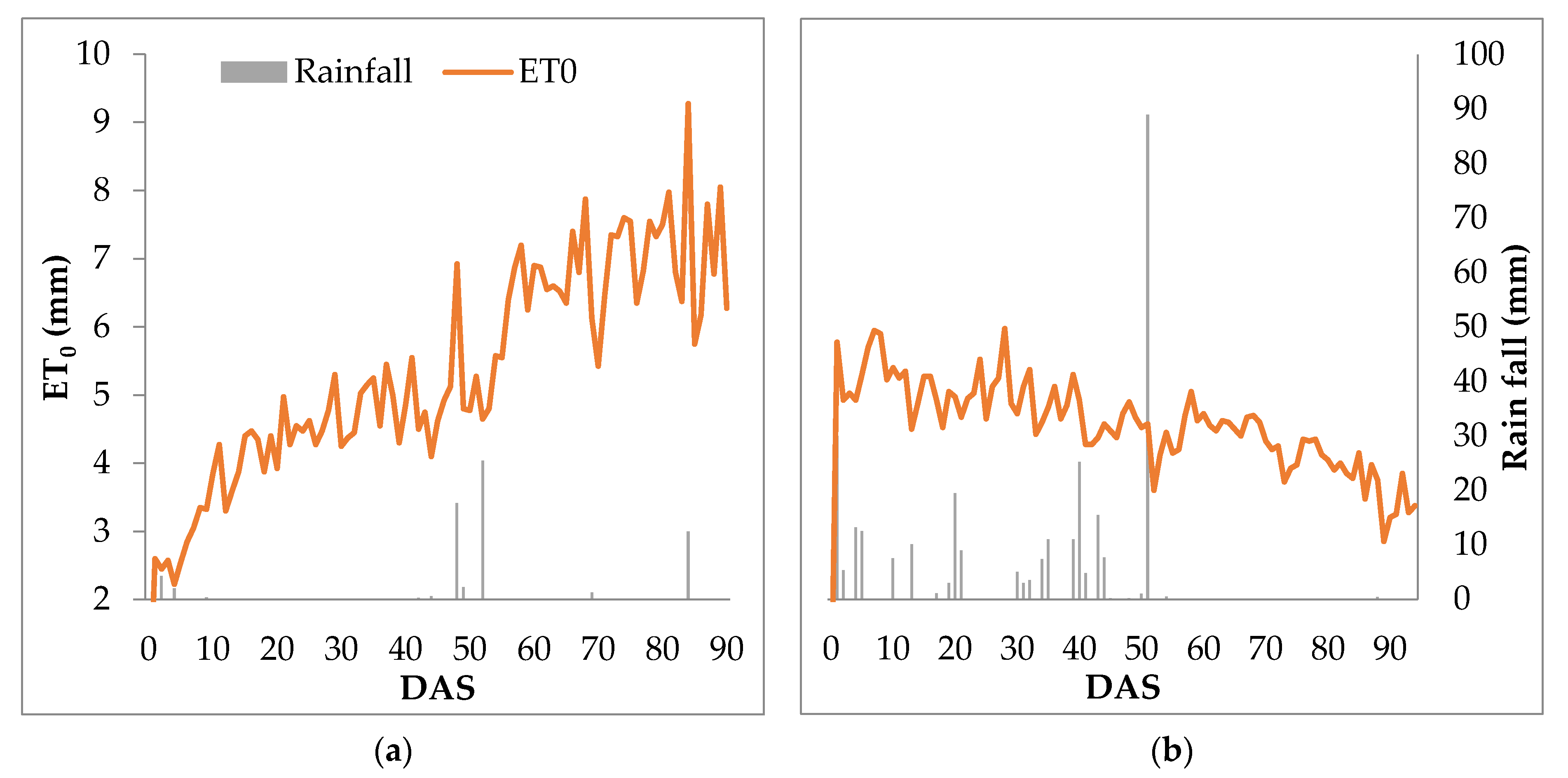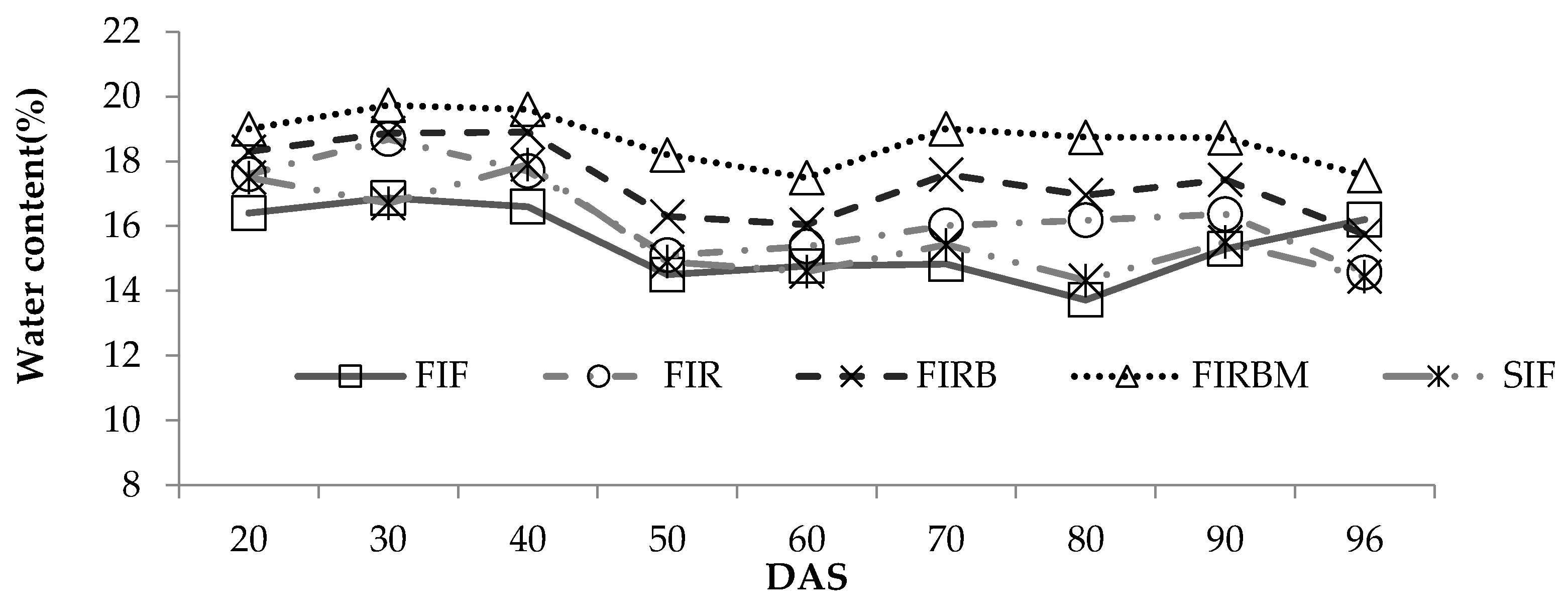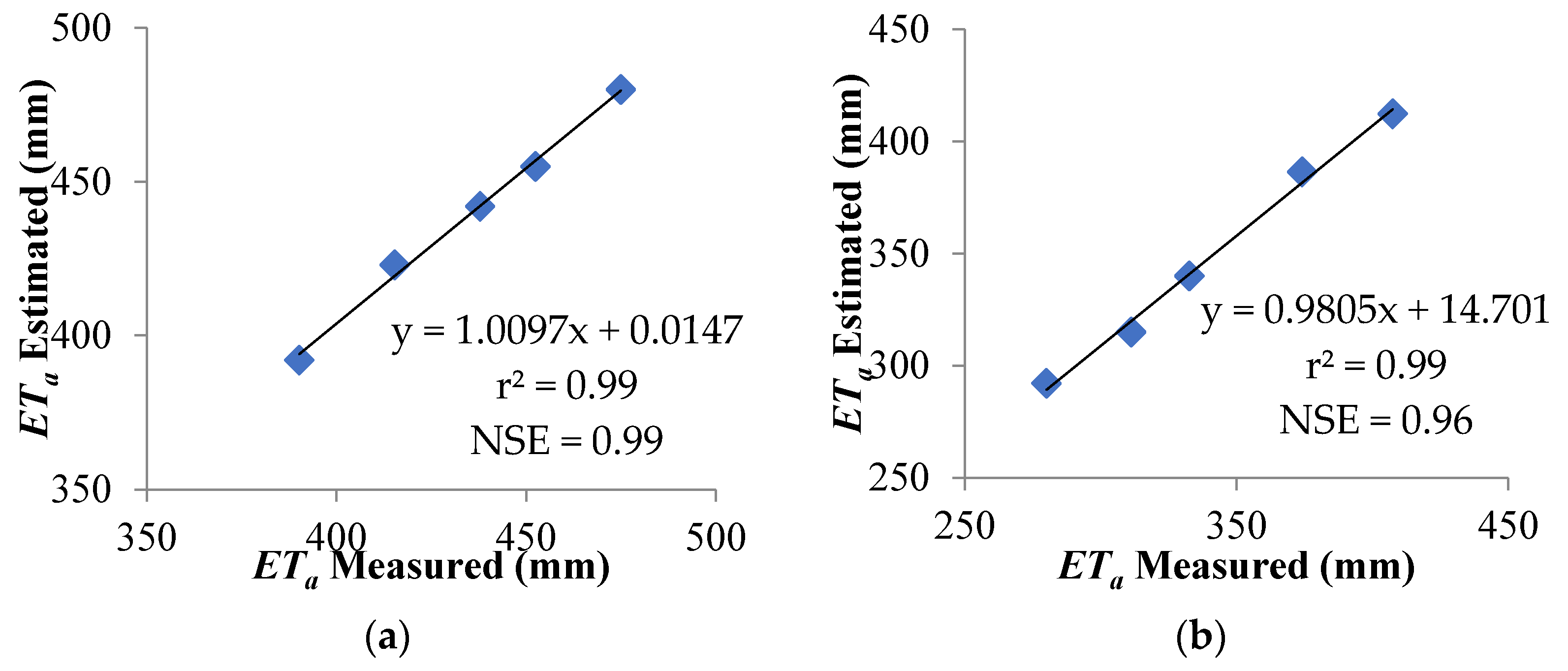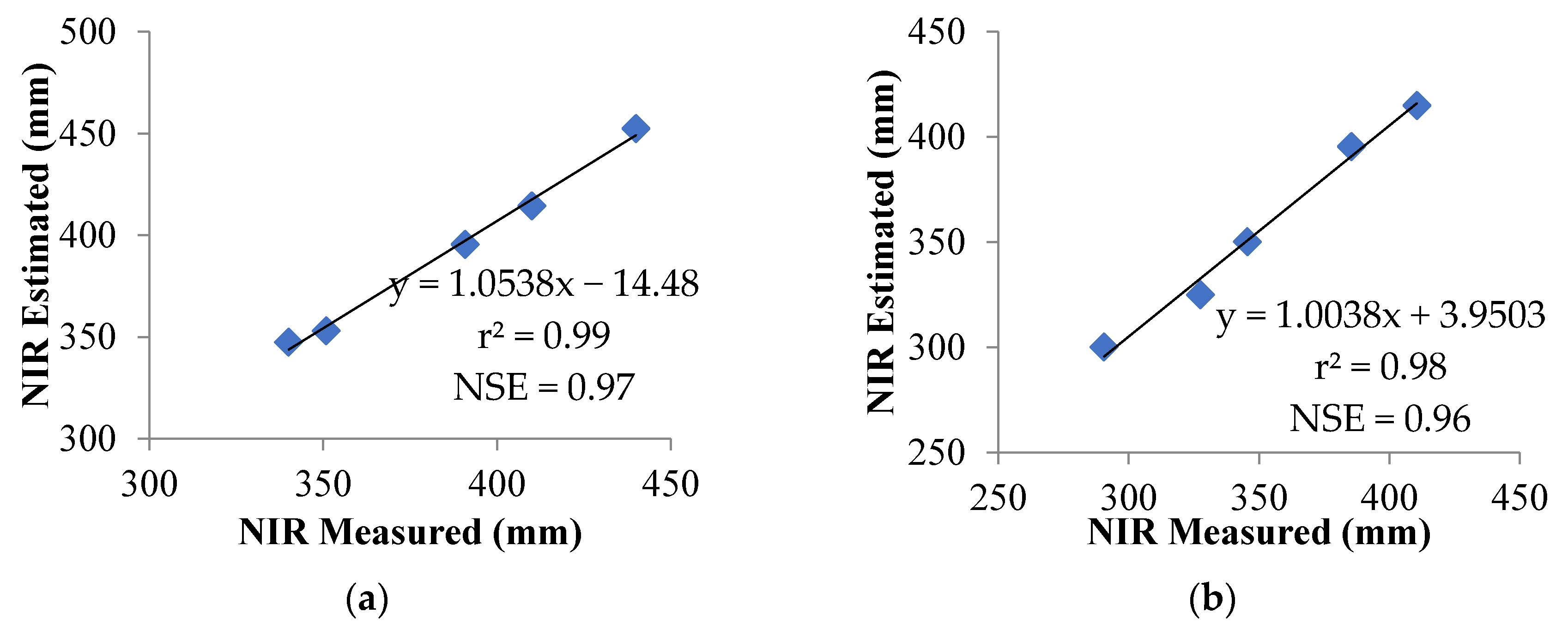Performance of Spring and Summer-Sown Maize under Different Irrigation Strategies in Pakistan
Abstract
:1. Introduction
2. Materials and Methods
2.1. Experimental Site and Setup
2.2. Experimental Treatments
2.3. Plant Measurements
2.4. Soil Water Content and Actual Evapotranspiration
2.5. Water Use Efficiency and Irrigation Water Use Efficiency
2.6. IManSys Model Simulation
2.7. Model Performance
2.8. Statistical Analysis
3. Results and Discussion
3.1. Soil Water Dynamics
3.2. Seasonal Water Balance among Different Irrigation Practices
3.3. Crop Growth and Yield
3.4. Water Use Efficiency (WUE) and Irrigation Water Use Efficiency (WUEi)
3.5. Performance of the IManSys Model
4. Conclusions
Author Contributions
Funding
Institutional Review Board Statement
Informed Consent Statement
Data Availability Statement
Acknowledgments
Conflicts of Interest
References
- Wolf, T.A. (Ed.) Conflict Prevention and Resolution in Water Systems; Edward Elgar Publishing Ltd: Cheltenham, UK, 2002. [Google Scholar]
- Seckler, D.; Upali, A.; Molden, D.; de Silva, R.; Barker, R. World Water Demand and Supply, 1990 to 2025: Scenarios and Issues. Research Report 19; Iwmi: Colombo, Sri Lanka, 1998. [Google Scholar]
- Kahlown, A.; Ashraf, M.; Hussain, M.; Salam, A.; Bhatti, A. Impact Assessment of Sewerage and Industrial Effluents on Water Resources, Soil, Crops and Human Health in Faisalabad; Pakistan Council of Research in Water Resources (PCRWR), Khyaban-e-Johar, H-8/1: Islamabad, Pakistan, 2006.
- Abdelrahman, M.A.E.; Arafat, S.M. An Approach of Agricultural Courses for Soil Conservation Based on Crop Soil Suitability Using Geomatics. Earth Syst. Environ. 2020. [Google Scholar] [CrossRef]
- FAO. Progress on Water Use Efficiency—Global Baseline for SDG 6 Indicator 6.4.1 2018; FAO: Rome, Italy, 2018. [Google Scholar]
- Byrne, J.; Quinn, G.; Mpitsos, J.; Lederhendler, I.; Belardetti, F.; Biondi, C. Plant Productivity and Environment. Science 1982, 218, 443–448. [Google Scholar]
- Khan, S.; Abbas, A. Upscaling water savings from farm to irrigation system level using gis-based agro-hydrological modelling. Irrig. Drain. J. Int. Comm. Irrig. Drain. 2007, 42, 29–42. [Google Scholar] [CrossRef]
- Govaerts, B.; Sayre, K.D.; Deckers, J. Stable high yields with zero tillage and permanent bed planting? Field Crops Res. 2005, 94, 33–42. [Google Scholar] [CrossRef]
- Fang, Q.; Ma, L.; Yu, Q.; Ahuja, L.R.; Malone, R.W.; Hoogenboom, G. Irrigation strategies to improve the water use efficiency of wheat–maize double cropping systems in North China Plain. Agric. Water Manag. 2010, 97, 1165–1174. [Google Scholar] [CrossRef]
- Kang, S.Z.; Zhang, L.; Liang, Y.L.; Hu, X.T.; Cai, H.J.; Gu, B.J. Effects of limited irrigation on yield and water use efficiency of winter wheat in the Loess Plateau of China. Agric. Water Manag. 2002, 55, 203–216. [Google Scholar] [CrossRef]
- Sayre, K.D. Effect of tillage, crop residue retention and nitrogen management on the performance of bed planting, furrow irrigated spring wheat in Northwest Mexico. In Proceedings of the 15th Conference International Soil and Tillage Research Organization, Fort Worth, TX, USA, 2–7 July 2000. [Google Scholar]
- Hassan, I.; Hussain, Z.; Akbar, G. Effect of permanent raised beds on water productivity for irrigated maize–wheat cropping system. Eval. Perform. Perm. Rais. Bed Crop. Syst. Asia Aust. Mex. 2005, 121, 59–65. [Google Scholar]
- Jay, L.; Jack, K.; Janet, K.L.; Thomas, B.K. Surface and Agricultural Water; John Wiley & Sons, Inc.: Hoboken, NJ, USA, 2005. [Google Scholar]
- Sharma, S.K. Principles and Practices of Irrigation Engineering; Oxford and IBH Publication Co.: New York, NY, USA, 1984. [Google Scholar]
- Haq, N. Evaluation of Modern Irrigation Techniques for Sandy Loam Soil Having Low Slopes. Master’s Thesis, Department of Irrigation and Drainage, University of Agriculture, Faisalabad, Pakistan, 1990. [Google Scholar]
- El Shirbeny, M.A.; Ali, A.M.; Savin, I.; Poddubskiy, A.; Dokukin, P. Agricultural Water Monitoring for Water Management Under Pivot Irrigation System Using Spatial Techniques. Earth Syst. Environ. 2020. [Google Scholar] [CrossRef]
- Li, X.Y.; Gong, J.D.; Gao, Q.Z.; Li, F.R. Incorporation of ridge and furrow method of rainfall harvesting with mulching for crop production under semiarid conditions. Agric. Water Manag. 2001, 50, 173–183. [Google Scholar] [CrossRef]
- Li, X.Y.; Gong, J.D. Effects of different ridge:furrow ratios and supplemental irrigation on crop production in ridge and furrow rainfall harvesting system with mulches. Agric. Water Manag. 2002, 54, 243–254. [Google Scholar] [CrossRef]
- Alewoye Getie, M.; Legesse, S.A.; Mekonnen, M.; Aschalew, A. Soil Properties and Crop Productivity Strategies as a Potential Climate Variability Adaptation Options in Adefwuha Watershed, Ethiopia. Earth Syst. Environ. 2020, 4, 359–368. [Google Scholar] [CrossRef]
- Sarmah, A.K.; Kookana, R.S.; Alston, A.M. Application of varleach and leachm models to experimental data on leaching of a non-reactive tracer and three sulfonylurea herbicides. Aust. J. Soil Res. 2001, 39, 1041–1058. [Google Scholar] [CrossRef]
- Fares, A. Water Management Software to Estimate Crop Irrigation Requirements or Consumptive Use Permitting In Hawaii; Department of Land and Natural Resources: Honolulu, HI, USA, 2008. Available online: http://treephys.oxfordjournals.org/cgi/reprint/15/9/611 (accessed on 26 December 2020).
- Khan, A.G.; Iqbal, M.; Ullah, E. Assessing the performance of different irrigation techniques to enhance the water use efficiency and yield of maize under deficit water supply The treatments consisted of four irrigation practices. Soil Environ. 2015, 34, 166–179. [Google Scholar]
- Finance Disvision, Government of Pakistan. Annonymous Economic Survey of Pakistan. 2018. Available online: http://www.finance.gov.pk/survey/chapters_19/Economic_Survey_2018_19.pdf (accessed on 26 December 2020).
- Bouyoucos, G.J. Hydrometer method improved for making particle size analyses of soils. Agron. J. 1962, 54, 464. [Google Scholar] [CrossRef]
- Ryan, J.; Estefan, G.; Rashid, A. Soil and Plant Analysis Laboratory Manual; ICARDA: Aleppo, Syria, 2001. [Google Scholar]
- Dane, J.H.; Hopmans, J.W. Laboratory Determination of Water Retention; Dane, J.H., Topp, G.C., Eds.; Method.; Soil Science Society of America, Inc.: Madison, WI, USA, 2002. [Google Scholar]
- Blake, G.R.; Hartge, K.H. Bulk density. In Methods of Soil Analysis, Part 1. Physical and Mineralogical Methods, Agronomy Monograph No. 9, 2nd ed.; Klute, A., Ed.; Wiley Online Library: Madison, WI, USA, 1986; pp. 363–375. [Google Scholar]
- Dwyer, L.M.; Stewart, D.W. Leaf Area Development in Field-Grown Maize. Agron. J. 1986, 78, 334–343. [Google Scholar] [CrossRef]
- Allen, R.G.; Pereira, L.S.; Raes, D.; Smith, M. Crop Evapotranspiration: Guidelines for Computing Crop Water Requirements; FAO Irrigation and Drainage Paper 56; Food and Agriculture Organization of the United Nations: Rome, Italy, 1998. [Google Scholar]
- Cassel, D.K.; Nielsen, D.R. Field Capacity and Available Water Capacity; John Wiley & Sons, Ltd.: Hoboken, NJ, USA, 2018; pp. 901–926. [Google Scholar]
- Hussain, G.; Al-Jaloud, A.A.; AI-Shammary, S.F.; Karimulla, S. Effect of saline irrigation on the biomass yield and the protein, nitrogen, phosphorus and potassium composition of alfalfa in a pot experiment. J. Plant Nutr. 1995, 18, 2389–2408. [Google Scholar] [CrossRef]
- Fares, A.; Fares, S. Irrigation Management System, IMANSYS, a User-Friendly Computer-Based Water Management Software Package. In Proceedings of the Irrigation Show and Education Conference, Orlando, FL, USA, 2–6 November 2012. [Google Scholar]
- Nash, J.E.; Sutcliffe, J.V. River flow forecasting through conceptual models part I—A discussion of principles. J. Hydrol. 1970, 10, 282–290. [Google Scholar] [CrossRef]
- Steel, R.G.D.; Torrie, J.H.; Dicky, D.A. Principles and Procedures of Statistics- A Biometrical Approach, 3rd ed.; McGraw Hill Book International Co.: New York, NY, USA, 1997; pp. 352–358. [Google Scholar]
- StatSoft, Inc. STATISTICA. Data Analysis Software System, Version 8. 2001. Available online: http://www.statsoft.com (accessed on 14 February 2018).
- Wang, F.H.; Wang, X.Q.; Sayre, K. Conventional, flood irrigated, flat planting with furrow irrigated, raised bed planting for winter wheat in China. Field Crop Res. 2004, 87, 35–42. [Google Scholar]
- Li, S.X.; Wang, Z.H.; Li, S.Q.; Gao, Y.J.; Tian, X.H. Effect of plastic sheet mulch, wheat straw mulch, and maize growth on water loss by evaporation in dryland areas of China. Agric. Water Manag. 2013, 116, 39–49. [Google Scholar] [CrossRef]
- Zhou, J.; Wang, C.; Zhang, H.; Dong, F.; Zheng, X.; Gale, W.; Li, S. Effect of water saving management practices and nitrogen fertilizer rate on crop yield and water use efficiency in a winter wheat-summer maize cropping system. Field Crops Res. 2011, 122, 157–163. [Google Scholar] [CrossRef]
- Sun, H.Y.; Liu, C.M.; Zhang, X.Y.; Shen, Y.J.; Zhang, Y.Q. Effects of irrigation on water balance, yield and WUE of winter wheat in the North China Plain. Agric. Water Manag. 2006, 85, 211–218. [Google Scholar] [CrossRef]
- Jat, M.L.; Srivastava, A.; Sharma, S.K.; Gupta, R.K.; Zaidi, P.H.; Rai, H.K.; Srinivasan, G. Evaluation of maize-wheat cropping system under double-no-till practice in indo-gangetic plains of India. In Proceedings of the Asian Regional Maize Workshop, Beijing, China, 5–9 September 2005. [Google Scholar]
- Deng, X.P.; Shan, L.; Zhang, H.; Turner, N.C. Improving agricultural water use efficiency in arid and semiarid areas of China. In Agricultural Water Management; Elsevier: Amsterdam, The Netherlands, 2006; Volume 80, pp. 23–40. [Google Scholar]
- Saif, U.; Masood, M.; Farooq, M.; Hussain, S.; Habib, A. Effect of planting patterns and different irrigation levels on yield and yield component of Maize (Zea mays L.). Int. J. Agric. Biol. 2003, 5, 64–66. [Google Scholar]
- Hamilton, G. Refinement and Adoption of Permanent Raised Bed Technology for the Irrigated Maize-Wheat Cropping System in Pakistan; Australian Centre for International Agricultural Research: Canberra, Australia, 2006. Available online: http://www.aciar.gov.au/project/LWR/2002/034 (accessed on 26 December 2020).
- Hobbs, P.R.; Singh, Y.; Giri, G.S.; Lauren, J.G.; Duxbury, J.M. Direct Seeding and Reduced Tillage Options in the Rice-Wheat Systems of the Indo-Gangetic Plains of South Asia; IRRI workshop: Bangkok, Thailand, 2000; pp. 25–26. [Google Scholar]
- Abbas, G.; Hussain, A.; Ahmad, A.; Wajid, S.A. Water use efficiency of maize as affected by irrigation schedules and nitrogen rates. J. Agric. Soc. Sci. 2005, 1, 339–342. [Google Scholar]
- Huang, Y.L.; Chen, L.D.; Fu, B.J.; Huang, Z.L.; Gong, J. The wheat yields and water-use efficiency in the Loess Plateau: Straw mulch and irrigation effects. Agric. Water Manag. 2005, 72, 209–222. [Google Scholar] [CrossRef]
- Zhang, S.L.; Lövdahl, L.; Grip, H.; Tong, Y.A.; Yang, X.Y.; Wang, Q.J. Effects of mulching and catch cropping on soil temperature, soil moisture and wheat yield on the Loess Plateau of China. Soil Tillage Res. 2009, 102, 78–86. [Google Scholar] [CrossRef]







| Depth (cm) | Particle Fractions (%) | B.D. | θs | θFC | θPWP | θAWC | Kfs | SOC | ||
|---|---|---|---|---|---|---|---|---|---|---|
| Sand | Silt | Clay | (Mg m−3) | -----cm3 cm−3----- | cm Day−1 | (%) | ||||
| 0–20 | 40.07 ± 0.12 | 37.41 ± 0.13 | 22.52 ± 0.10 | 1.45 ± 0.10 | 0.44 ± 0.03 | 0.29 ± 0.01 | 0.13 ± 0.01 | 0.16 ± 0.01 | 28.31 ± 1.55 | 0.50 ± 0.37 |
| 20–40 | 43.47 ± 0.15 | 34.08 ± 0.12 | 22.45 ± 0.14 | 1.48 ± 0.03 | 0.44 ± 0.02 | 0.27 ± 0.01 | 0.12 ± 0.01 | 0.15 ± 0.01 | 27.27 ± 3.01 | 0.34 ± 0.45 |
| 40–60 | 45.24 ± 0.22 | 32.30 ± 0.23 | 22.46 ± 0.12 | 1.55 ± 0.02 | 0.43 ± 0.02 | 0.27 ± 0.01 | 0.12 ± 0.01 | 0.15 ± 0.01 | 19.52 ± 4.25 | 0.28 ± 0.18 |
| 60–100 | 46.38 ± 0.19 | 31.21 ± 0.14 | 22.41 ± 0.14 | 1.59 ± 0.02 | 0.42 ± 0.01 | 0.27 ± 0.013 | 0.12 ± 0.01 | 0.15 ± 0.01 | 20.00 ± 2.35 | 0.22 ± 0.28 |
| Treatments | Spring | Summer | ||||||||||
|---|---|---|---|---|---|---|---|---|---|---|---|---|
| Measured (mm) | Estimated (mm) | Measured (mm) | Estimated (mm) | |||||||||
| NIR | ETa | ΔS | NIR | ETa | ΔS | NIR | ETa | ΔS | NIR | ETa | ΔS | |
| * FIF | 420 a + | 475 a | −55 d | 428 a | 480 a | −52 c | 410.5 a | 407.5 a | 3.0 d | 415 a | 412.3 a | 2.7 d |
| FIR | 410 b | 457.5 b | −47.5 c | 414.5 b | 460 b | −55.5 d | 385.5 b | 374.2 b | 11.3 c | 395.5 b | 386.4 b | 9.1 b |
| FIRB | 390.8 c | 437.8 c | −47.0 bc | 395.5 c | 442 c | −46.5 bc | 345.5 c | 332.7 c | 12.8 b | 350.3 c | 340 c | 10.3 a |
| FIRBM | 370.8 d | 405.3 d | −34.5 a | 372 d | 410 d | −38 a | 327.5 d | 311.2 d | 16.3 a | 325 d | 315 d | 10.0 a |
| SIF | 340 d | 390.2 e | −50.2 b | 347.5 d | 392 e | −44.5 b | 290.5 e | 280 e | 10.5 c | 300.2 e | 292.2 e | 8.0 c |
| Treatments | Spring | Summer | ||||
|---|---|---|---|---|---|---|
| Grain Yield (Mg ha−1) | Biomass (Mg ha−1) | Harvest Index | Grain Yield (Mg ha−1) | Biomass (Mg ha−1) | Harvest Index | |
| FIF | 5.67 c + | 14.2 a | 0.39 c | 6.04 bc | 16.1 a | 0.37 c |
| FIR | 6.06 abc | 13.6 abc | 0.44 b | 6.16 bc | 15.1 bc | 0.40 b |
| FIRB | 6.16 ab | 13.9 ab | 0.44 b | 6.26 ab | 15.3 ab | 0.40 b |
| FIRBM | 6.32 a | 12.8 c | 0.45 a | 6.58 a | 14.8 bc | 0.44 a |
| SIF | 5.80 bc | 13.1 bc | 0.44 b | 5.87 c | 14.3 c | 0.40 b |
| LSD (p ≤ 0.05) | 0.48 | 1.10 | 0.01 | 0.37 | 0.91 | 0.01 |
| Treatments | Spring | Summer | ||
|---|---|---|---|---|
| WUE (kg ha−1 mm−1) | WUEi (kg ha−1 mm−1) | WUE (kg ha−1 mm−1) | WUEi (kg ha−1 mm−1) | |
| FIF | 11.9 d + | 13.5 d | 14.8 c | 14.7 c |
| FIR | 13.3 c | 14.7 c | 16.4 c | 15.9 b |
| FIRB | 14.0 b | 15.7 b | 18.8 b | 18.1 ab |
| FIRBM | 15.2 a | 17.2 a | 21.1 a | 20.2 a |
| SIF | 14.8 ab | 17 ab | 20.9 ab | 20.0 a |
Publisher’s Note: MDPI stays neutral with regard to jurisdictional claims in published maps and institutional affiliations. |
© 2021 by the authors. Licensee MDPI, Basel, Switzerland. This article is an open access article distributed under the terms and conditions of the Creative Commons Attribution (CC BY) license (http://creativecommons.org/licenses/by/4.0/).
Share and Cite
Khan, A.G.; Imran, M.; Khan, A.-u.-H.; Fares, A.; Šimůnek, J.; Ul-Haq, T.; Alsahli, A.A.; Alyemeni, M.N.; Ali, S. Performance of Spring and Summer-Sown Maize under Different Irrigation Strategies in Pakistan. Sustainability 2021, 13, 2757. https://doi.org/10.3390/su13052757
Khan AG, Imran M, Khan A-u-H, Fares A, Šimůnek J, Ul-Haq T, Alsahli AA, Alyemeni MN, Ali S. Performance of Spring and Summer-Sown Maize under Different Irrigation Strategies in Pakistan. Sustainability. 2021; 13(5):2757. https://doi.org/10.3390/su13052757
Chicago/Turabian StyleKhan, Abdul Ghaffar, Muhammad Imran, Anwar-ul-Hassan Khan, Ali Fares, Jiří Šimůnek, Tanveer Ul-Haq, Abdulaziz Abdullah Alsahli, Mohammed Nasser Alyemeni, and Shafaqat Ali. 2021. "Performance of Spring and Summer-Sown Maize under Different Irrigation Strategies in Pakistan" Sustainability 13, no. 5: 2757. https://doi.org/10.3390/su13052757
APA StyleKhan, A. G., Imran, M., Khan, A.-u.-H., Fares, A., Šimůnek, J., Ul-Haq, T., Alsahli, A. A., Alyemeni, M. N., & Ali, S. (2021). Performance of Spring and Summer-Sown Maize under Different Irrigation Strategies in Pakistan. Sustainability, 13(5), 2757. https://doi.org/10.3390/su13052757








